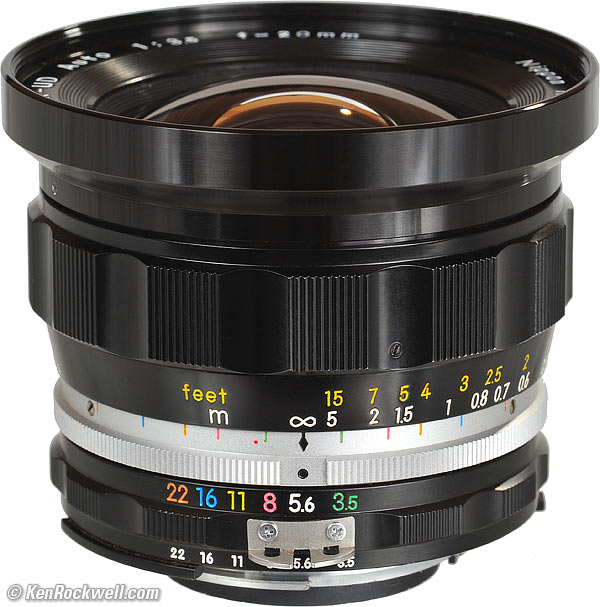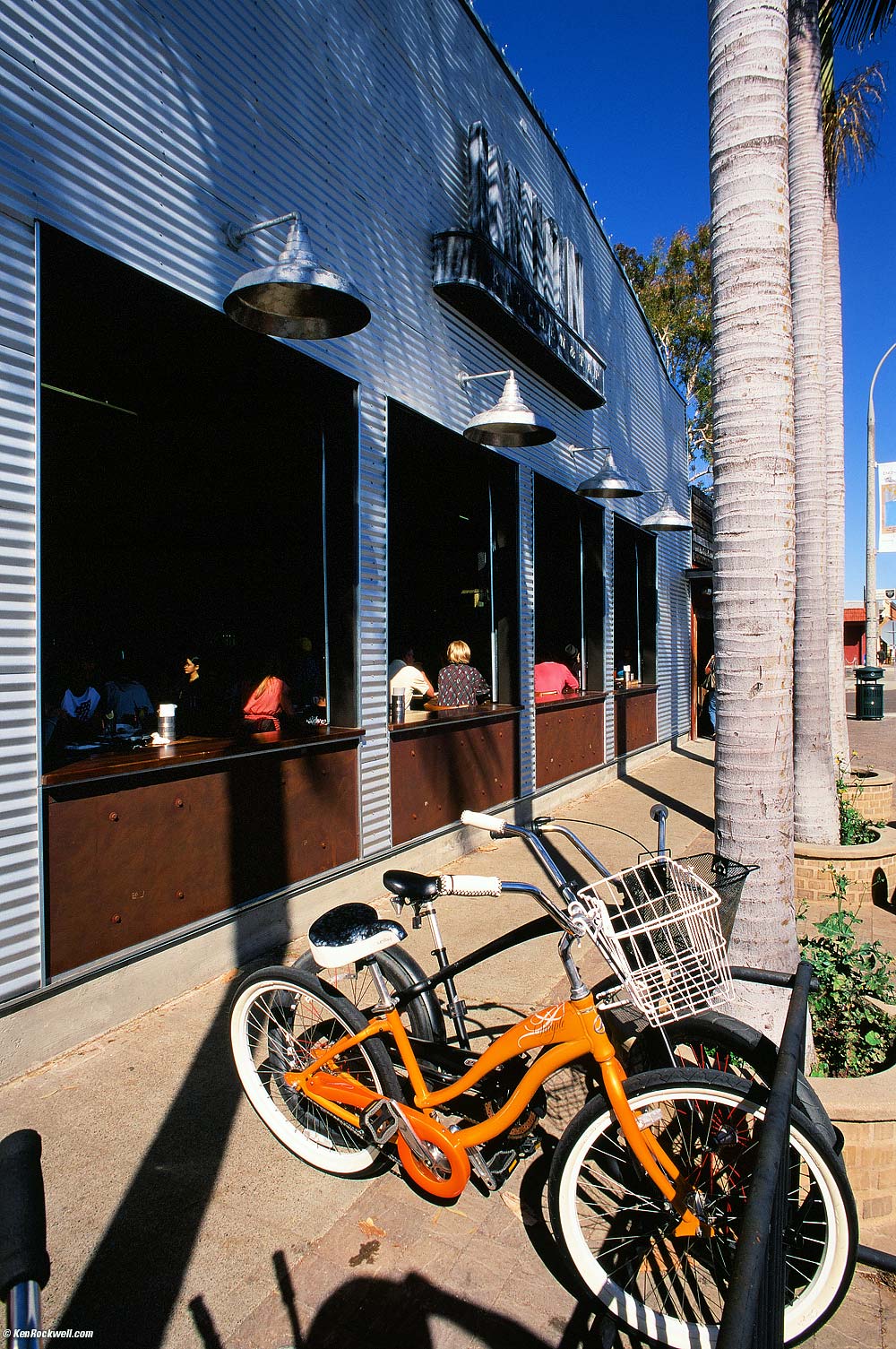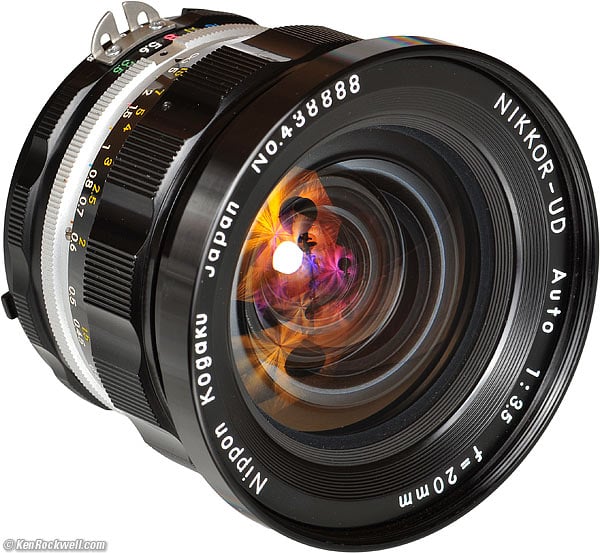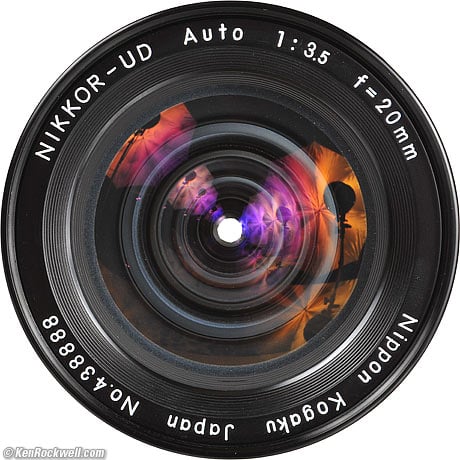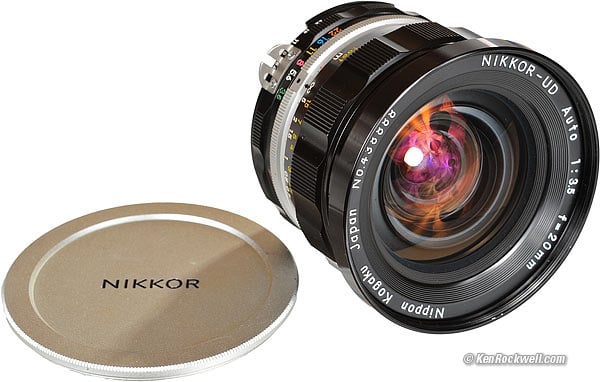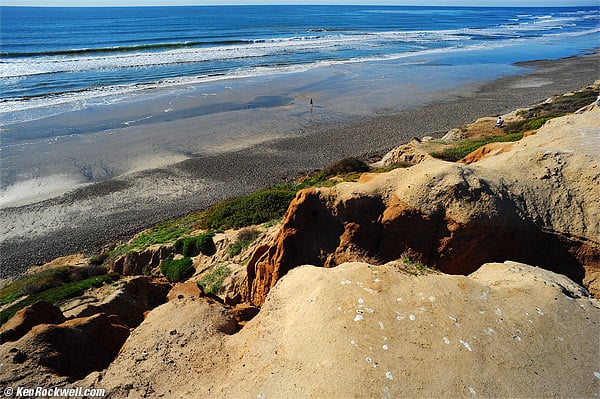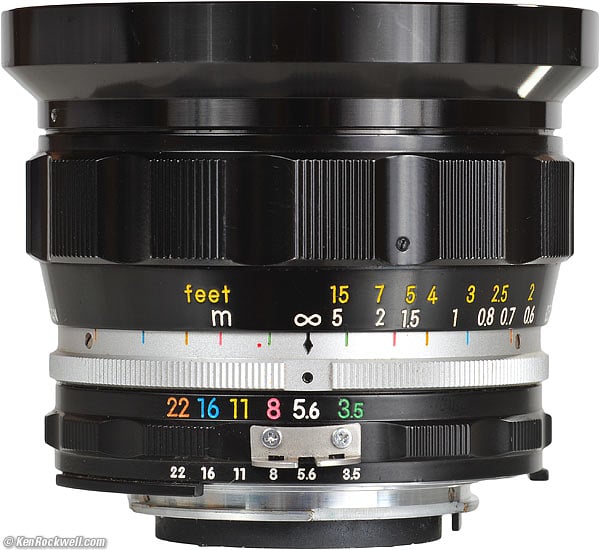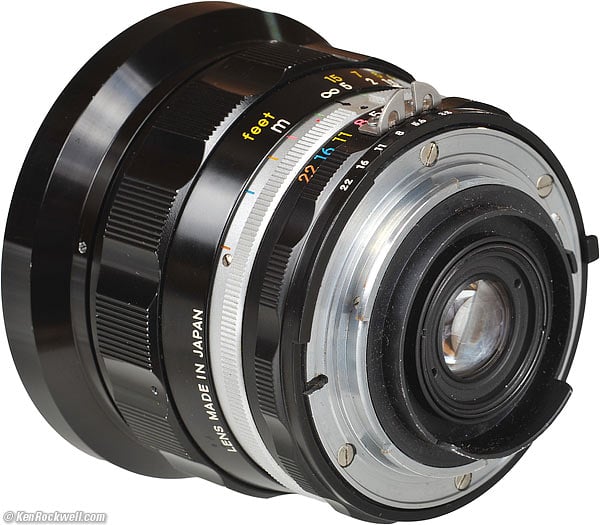Home Donate New Search Gallery How-To Books Links Workshops About Contact
Nikon 20mm f/3.5
NIKKOR-UD Auto (1967-1974)
© 2011 KenRockwell.com. All rights reserved.
Intro Specifications Performance Compared Recommendations
Nikon 20mm f/3.5 NIKKOR-UD Auto, factory AI-updated (72mm filters, 13.7 oz./388g, 1'/0.3m close focus, about $225 used). enlarge. This free website's biggest source of support is when you use any of these links, especially this direct link to this lens at eBay (see How to Win at eBay) when you get anything, regardless of the country in which you live . Thanks! Ken.
June 2013 More Nikon Reviews Nikon Lenses All Reviews
Sharpness Comparison to other 20mm lenses
Ideal Uses
Excellent ultrawide for FX and 35mm.
Not for
I wouldn't bother with this on a DX camera. I'd use any DX lens, like the 18-55mm kit lens, instead. As a manual focus lens, I wouldn't use it for sports, kids or action since it's too hard to track focus by hand.
| Optics: | |
| Ergonomics: | |
| Usefulness: | |
| Availability: | |
| Overall: |
Sample Image File
Encinitas, 9:53 AM, 04 March 2012. (Nikon F2S, 20mm f/3.5 NIKKOR-UD, Nikon A2 filter, Fuji Velvia 50, f/10 at 1/60, NCPS process and scan.) Full Resolution.
Introduction top
Intro Specifications Performance Compared Recommendations
| Adorama pays top dollar for your used gear. I use these stores. I can't vouch for ads below. |
This Nikon 20mm f/3.5 UD is Nikon's first 20mm lens. At its introduction in 1967, it was the widest non-fisheye lens ever made by Nikon.
This 20/3.5 UD is bigger than Nikon's newer 20mm lenses, and has the same excellent optical performance.
UD stands for the optical element count: U for Uni (1), and D for deci (10). 1 + 10 = 11, as this lens has 11 elements. It has nothing to do with ED lenses which come later. I refer to this lens as the 20mm f/3.5 UD to differentiate it from the smaller and newer 20mm f/3.5 AI and AI-s (1977-1984)
The manual-focus Nikon 20mm f/3.5 UD works great with most Nikon cameras, film and digital — if it's been updated to AI. If it hasn't been updated, it's called an F-mount or non-AI lens, and while it works perfectly on every Nikon SLR made up through 1976, will have more limited utility with more recent Nikons.
Presuming yours is AI-updated, the 20mm f/3.5 UD works flawlessly with every manual focus Nikon ever made, from the F of 1959 through the FM3a and today's FM-10.
When AI-updated, on the D3X, D3s, D3, D700, D300, D200, D2 and F6, use the "Non-CPU Lens Data" menu option to set 20mm and f/3.5 to get full color matrix metering, EXIF data and finder read-out of set aperture. It works great in aperture-preferred as well as manual modes on these cameras.
When AI-updated, it works perfectly on every professional film camera (F, F2, F3, F4, F5, F6), and adds Matrix metering on the F6.
The meters of cheaper digital (D90, D5000 and below) and cheaper film cameras (N80 and below) will not couple (or work at all) with this lens, so you'll be on your own guessing exposure using the rear LCD or an external meter, or get a tiny Gossen Digisix meter and hotshoe adapter to meter manually.
See Nikon Lens Compatibility for details on your camera. If your 20mm f/3.5 is as it originally shipped (not AI), read down the "Pre-AI" column, and if it's been AI-updated, read down the "AI Converted" column.
1959-1967
Nikon repackaged their 2.1cm (21mm) f/4 rangefinder lens, originally designed for the Nikon SP, for the F-mount SLRs.
It required the use of mirror lockup and a separate finder slid over the funky rewind crank of the NIkon F, as it poked all the way into the camera.
Nikon made about 5,000 of the 2.1cm f/4 lenses.
1967-1974
This UD 20mm f/3.5 was Nikon's ultrawide for the late 1960s and early 1970s. There was no wider non-fisheye lens made by Nikon until the insane 15mm f/5.6 of 1973 and the 18mm f/4 of 1974.
Nikon made about 40,000 of these 20mm f/3.5 UD lenses.
1974-1978
Nikon's tiny 20mm f/4 (52mm filters), the smallest ultrawide ever made by Nikon or Canon, replaced the big 20/3.5 UD, with similar optical performance.
In 1975 Nikon introduced the world's widest non-fisheye lens, the Nikkor 13mm f/5.6, which remains today a the world's widest professional SLR lens ever made.
Nikon made about 35,000 of the 20mm f/4 lenses.
1978-1984
Nikon replaced the tiny 20mm f/4 with an almost-as-tiny 20mm f/3.5, which also takes 52mm filters.
Nikon made about 55,000 of the 20mm f/3.5 AI and AI-s lenses.
1984-today
Nikon replaced the tiny 20mm f/3.5 with today's 20mm f/2.8, which takes 62mm filters and is sold today in both manual-focus AI-s and autofocus versions.
Nikon has made about 70,000 of the 20mm f/2.8 AI-s lenses as of 2010, and still makes them today.
Nikon has made about 115,000 of the 20mm f/2.8 AF and AF-D lenses as of 2010, and still makes them today.
Nikon 20mm f/3.5 UD. enlarge.
Specifications top
Intro Specifications Performance Compared Recommendations
Name top
Nikon calls this the Nikon NIKKOR-UD Auto 20mm f/3.5.
Optics top
11 elements in 9 groups.
Single coated in blue and amber.
Traditional spherical design, no CRC.
Actual (Design) Focal Length top
20.4mm.
Used on a DX camera it gives an angle of view similar to what a 30mm lens would give on an FX or 35mm film camera. See also Crop Factor.
Angle of View top
94° on FX and 35mm.
71° on small-format DX.
Filter Thread top
72mm.
Doesn't rotate.
Diaphragm top
Nikon 20mm f/3.5 UD at f/5.6. enlarge.
7 blades.
Stops down to f/22.
Aperture Ring top
Yes.
Metal.
Full-stop clicks.
Hard Infinity Focus Stop? top
YES.
Close Focus top
1 foot.
0.3 meters.
Maximum Reproduction Ratio top
1:11.
Focus Distance Scale? top
Yes, very precise.
Depth-of Field Scale? top
Yes, very precise.
Infra-Red Focus Index? top
Yes, dot near the f/3.5 line.
Size top
2.284" extension from flange by 2.948" diameter (58.03 x 74.88mm), measured.
Nikon specifies 57.5 x 75mm.
Weight top
AI-updated (as shown): 13.680 oz. (387.8g), measured.
F-mount, (not shown, as originally shipped): 13.655 oz. (387.15g), measured.
Nikon specifies 390g.
Solid billet aluminum 72 N cap: 0.785 - 0.805 ounces (22.3 - 22.9g), measured.
Hood top
HN-9 metal screw-in.
Case top
CL-34, also try number 51.
Caps top
Nikon 20mm f/3.5 UD and 72 N front cap. enlarge.
The Nikon 20/3.5 UD takes standard 72mm front and Nikon rear caps.
If you're lucky, your 20 UD will come with the original solid-billet aluminum 72 N screw-in cap, which is a work of art. It is hewn from solid aluminum, and its markings are all hand-engraved. It's less convenient than today's plastic cap, but it sure feels nice when it's on.
Made in top
Japan.
Performance top
Intro Specifications Performance Compared Recommendations
Overall Focus Bokeh Color Coma Distortion
Ergonomics Falloff Filters Ghosts Color Fringes
Overall performance top
The 20mm f/3.5 UD is a swell lens.
Performance is pretty much indistinguishable from today's newest 20mm f/2.8 AI-s and 20mm f/2.8 AF-D lenses. The difference is that this 1960s lens is simply bigger and heavier, but still far smaller and lighter than any ultrawide zoom other than the plastic 18-35mm AF-D.
Focus performance top
Manual focus is perfect.
Focus turns about 150º from near to far, so it is very precise and ideal for careful use with the easy-to-read depth-of-field scale. It is a joy compared to today's crummy zooms and their lack of scales, and often even decent focus rings!
The D3, D3X, D3s, D700, F4, F5, F6 and most professional AF cameras have three very precise electronic manual focus indicators, with which this lens works perfectly.
Lesser digital cameras, like the D300s and down, usually have just one "OK" focus dot, which is not as precise as two arrows and a dot.
Bokeh performance top
With a 20mm f/3.5 lens you're not likely to get any backgrounds out of focus, but if you do, bokeh, the character of out-of-focus backgrounds, not simply how far out of focus they are, is mediocre.
Background blur circles are soft, but usually with darker centers and brighter outer rings.
Color Rendition performance top
The color rendition of this Nikon 20mm f/3.5 UD is pretty close to modern multi-coated NIKKORs.
If you see any difference, it is a little more green-yellow.
Coma performance top
I don't see any significant coma.
Distortion performance top
The Nikon 20mm f/3.5 has little distortion. It bloats-out a little in the center, and gets straight again towards the sides.
Vertical lines on either side, about 1/2 to all the way out, stay relatively straight.
Here's an uncorrected FX image of the sea, with the horizon along the top:
La Jolla Cliffs on FX, uncorrected. enlarge.
If correcting it with simple tools like Photoshop's lens distortion filter, some slight waviness will be left after these corrections. These aren't facts or specifications, they are the results of my research that requires hours of photography and calculations on the resulting data.
If shot on DX, which is silly, you see more distortion because you're only using the center of the image, where distortion is strongest, but much easier to correct.
FX and Film |
||
∞ |
+0.5* |
+2.5 |
10' (3m) |
+0.5* |
© 2010 KenRockwell.com. All rights reserved.
* Some waviness remains
Ergonomics performance top
Nikon 20mm f/3.5 UD. enlarge.
The Nikon 20mm f/3.5's ergonomics are marvelous: a big focus and a big aperture ring that you need, with plenty of room to work them.
The widening front keeps your fingers out of your photos.
Falloff (darkened corners) performance top
Falloff is visible wide-open and at f/4, mostly goes away at f/5.6, and is gone at f/8.
Falloff on FX is exactly the same as Nikon's other 20mm lenses and wide zooms.
See my 20mm lens falloff comparison.
It won't be an issue at all on DX (see crop factor).
I've exaggerated this by shooting a gray field and placing these on a gray background.
Nikon 20mm f/3.5 UD falloff on FX and film at infinity, no correction.
© 2010 KenRockwell.com. All rights reserved.
|
Filters, Use with performance top
A traditional Nikon or Hoya 72mm filter works great, with no vignetting on 35mm or FX.
If you use a thick filter, like most rotating-mount filters, you will get some minor vignetting.
Don't use a polarizer; they don't work with well with any 20mm lens because the polarization of nature itself varies over such a broad angle.
If using a rotating grad, use the new Tiffen HTs, which are in thin mounts.
You can use a 72->77mm step-up ring, but get just the tiniest bit of vignetting with a traditional filter. I wouldn't worry about it, if you're using a normal or thin 77mm filter.
Flare and Ghosts performance top
If you have the sun in your image, you'll get a track of small magenta and blue dots streaming across your image.
This makes this 20mm UD less perfect technically than newer 20mm lenses, while some people love getting this effect with ultra-wide shots, and have to use software to add these back in with newer lenses.
This effect is minor; you have to get the disc of the sun in your image to get these small dots with the 20/3.5 UD.
Lateral Color Fringes performance top
There are no lateral color fringes when shot on the D3, which would correct them.
I'm sure there are lateral color fringes; just that the D3 marvelously corrects for them.
Mechanics performance top
Nikon 20mm f/3.5 UD. enlarge.
Like all Nikon manual focus lenses, the Nikon NIKKOR-UD 20mm f/3.5 Auto is built to the highest mechanical standards of any lens.
It is normal for the front filter ring to have a little play. If this bothers you, look carefully, and you'll discover that the front filter ring wiggles, while the optics and identity ring are separate and don't move!
Barrel Exterior
Anodized and enameled aluminum.
Filter Threads
Anodized aluminum.
Focus Ring
Metal, fluted.
Focus Helicoids
Feels like brass.
Depth-of-Field Scale
Engraved into silver barrel-grip and filled with different colors of paint.
Internals
All metal.
Aperture Ring
Cast aluminum, anodized and enameled.
Engraved markings filled with different colors of paint coded to the depth-of-field scale.
Mount
Dull-chromed brass.
Markings
Engraved into the metal and filled with paint.
Identity and Serial Number
On the front of the lens, inside the filter ring, engraved into the metal and filled with paint.
Ass-Gasket (dust seal at mount)
No.
Noises When Shaken
Assorted clunking. Hold the front filter ring and less rattles.
Made in
Japan.
Sharpness performance top
Warning 1: Image sharpness depends more on you than your lens.
Warning 2: Lens sharpness doesn't mean much to good photographers.
With those caveats, the 20mm f/3.5 UD is as sharp as today's fixed 20mm lenses and ultrawide zooms!
The only two sharper Nikon lenses, and then only in the corners at large apertures, are the 16-35mm VR and the 14-24mm, which weigh and cost many times more than this old classic.
As seen on a 12 MP FX camera (D3 and D700)
At f/3.5 and f/4
The center is perfectly sharp.
The corners are a little less sharp
At f/5.6
The corners are about the same, just brighter from the lack of falloff.
At f/8
The corners are sharper.
At f/11 and smaller
The corners get a little better as stopped down, but there isn't much difference from f/8.
Even though the corners are improving as stopped down, diffraction will limit performance in the center.
Sunstars performance top
With its straight 7-bladed diaphragm, the 20mm f/3.5 should makes great Nikon-standard 14 -pointed sunstars on bright points of light.
Compared top
Intro Specifications Performance Compared Recommendations
Oddly, I carefully compared this to eight other Nikon fixed 20mm and ultrawide zooms, and except for the superior 16-35mm and 14-24mm, they are all pretty much the same sharpness overall!
I compared the 20/3.5 UD, 20/4 AI, 20/3.5 AI, 20/2.8 AI-s, 20/2.8 AF, 20-35mm, 17-35mm, 18-35mm and 14-24mm. Wow! Yes, they were all different, but different in different ways in different places, thus in all, they were each as sharp as the next. (The 16-35mm and 14-24mm were superior, but everything else was the same.)
Sharpness Comparison to other 20mm lenses
| Anni | 2010- |
2009- |
1984- |
1977-1984 |
1974-1978 |
1967-1974 |
| Filter | 77mm |
52mm |
62mm |
52mm |
52mm |
72mm |
| Threads | Plastic |
Metal |
Metal |
Metal |
Metal |
Metal |
| Barrel | Plastic |
Metal |
Metal |
Metal |
Metal |
Metal |
| Weight | 678g |
199.5g |
259g |
232g |
209g |
388g |
| Weight | 23.9 oz. |
7.040 oz. |
9.1 oz. |
8.2 oz. |
7.4 oz. |
13.7 oz. |
| Price, USA, September 2010 |
Recommendations top
Intro Specifications Performance Compared Recommendations
The Nikon 20mm f/3.5 UD is a manual-focus only lens.
Optically it's is as good as today's fixed Nikon lenses. What's been improved over the decades is that newer lenses are smaller and have fewer ghosts.
If you have one of these or can find a bargain on one, get it, but if not, the newer models do the same thing and are smaller probably for about the same price used.
This 20mm UD is starting to catch the eyes of collectors, so its price reflects a bit of history as well as utility.
If you prefer the Space Age, by all means get one of these. This impressive lens works very well.
Deployment top
I'd leave either a 72mm Nikon Clear (NC - UV) filter, or a 72mm Hoya Super HMC UV on the lens at all times. I wouldn't worry about a hood.
I'd also leave the solid aluminum screw-in cap at home and use a new 72mm pinch-type cap. I'm not kidding: the new fatter caps are much easier to use in the field.
Help me help you top
I support my growing family through this website, as crazy as it might seem.
The biggest help is when you use any of these links when you get anything, regardless of the country in which you live. It costs you nothing, and is this site's, and thus my family's, biggest source of support. These places have the best prices and service, which is why I've used them since before this website existed. I recommend them all personally.
If you find this page as helpful as a book you might have had to buy or a workshop you may have had to take, feel free to help me continue helping everyone.
If you've gotten your gear through one of my links or helped otherwise, you're family. It's great people like you who allow me to keep adding to this site full-time. Thanks!
If you haven't helped yet, please do, and consider helping me with a gift of $5.00.
As this page is copyrighted and formally registered, it is unlawful to make copies, especially in the form of printouts for personal use. If you wish to make a printout for personal use, you are granted one-time permission only if you PayPal me $5.00 per printout or part thereof. Thank you!
Thanks for reading!
Mr. & Mrs. Ken Rockwell, Ryan and Katie.
Home Donate New Search Gallery Reviews How-To Books Links Workshops About Contact

